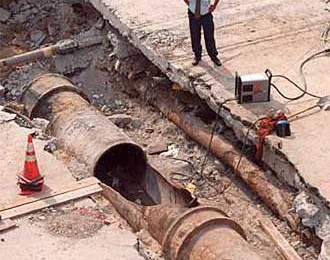Whether you live in Buffalo, Rome, Albany, Brooklyn or Long Island your toilet, your view, your favorite beach, your water supply are all part of our shared water and sewer systems. Our favorite places and most pressing needs interconnect and interrelate and they are among the most under-funded parts of our generally under-funded infrastructure statewide.
I pay $200 a year or so to the City of Albany to receive as much fresh drinkable water as I want every day. With a flush or the swoop of a drain, my dirty used water flows away. That’s less than 60 cents a day! A week’s worth of water/sewer for the price of one latte. It is truly incredible if I ponder it. Truly, most of us do not. In truth, we take water and sewer more for granted than the many things we take for granted.
We live in a state surrounded by Great Lakes and ocean. We are blessed with beautiful rivers, lakes and waterways. Reservoirs, aqueducts, sewer lines and treatment plants abound. Mother Nature and prior generations have endowed us with natural and manmade systems that underlie our ability to enjoy life, liberty and the pursuit of happiness.
Still, from one end of the state to the other, the systems that supply and move and test and treat our water are inadequate, under threat and under-funded. And this has real world consequences. For years, we have known that our rain water systems merge with our sewer systems, leading to sewage releases after rainfalls as small as .25”. This problem exists from Lake Erie to Erie Basin, Brooklyn and too many points in between.
Earlier this fall while paddling, I wandered into that infrastructural shortcoming in the Vloman Kill in a little town named Bethlehem on the Hudson River just south of Albany. A smell arose but unsure of its source; I paddled on past a farm to a waterfall. This singularly beautiful spot was marred that day by an overflow release from the town’s treatment plant. The Hudson River Keeper tells us that such planned discharges are all too common.
I knew I would not get splashed. I knew I could rinse and cleanse my brand new kayak. The water was placid but the river was being polluted, as were the local “organic” chickens and ducks that waded into and drank from that Kill.
I have paddled past each of New York City’s fourteen sewage treatment plants and never smelled a “release”. I have paddled a thousand miles in New York State waters and never seen what is dubbed as a “floatable”. I know from super storm Sandy however that these plants are highly vulnerable and will be more so as sea level and deferred maintenance accelerate.
Governor Cuomo has stated over and over again that extreme weather events are on the rise with extreme water, sea and rain events almost defining his governorship. He is spending funds even today to make some of our communities more resilient. But more is needed. And right now, they say, we have some extra.
It is a sad and ugly irony that when Western New York’s recent seven-foot overdose of wet, white snow, melts, much of it will find its way into regional sewer systems, overloading the treatment plants, sending polluted water into the Great Lakes. Buffalo, sadly, pumps much of its drinking water from nearby Lake Erie.
That’s a hell of a lake effect. Clean water in the lake is turned into snow by an extreme cold weather event, dumped on shore, causing death and destruction, only to flow back polluted to Erie and Ontario through our under-funded inadequate infrastructure. Buffalonians must then pay to treat it and drink it.
At a recent Omega Institute conference in Rhinebeck, New York, a Harbor School teacher spoke of the horrible smell that filled the Hudson and East Rivers surrounding Governors Island from systems overloaded from rainfalls. Meanwhile Omega has built and operates a state-of-the-art decentralized natural wastewater treatment system.
When sewage treatment plants fail in Rome and Utica on the Mohawk River, the discharge threatens fishing, wildlife and home values for two hundred fifty miles all the way to new housing developments on the NYC waterfront. If our rivers are allowed to turn into the sewers that we let them be for much of the twentieth century before the Clean Water Act of 1971, high value, high tax paying shoreline development will be stymied. Property, sales and income taxes needed to pay for needs statewide would be reduced. We are all connected here and we will all pay for failure.
On the other hand…we have a way forward, and yes, it involves some money. New York should commit to ensuring the adequacy, reliability and energy efficiency of our water and sewer systems. To do this, Empire State Future proposes that:
- New York State amends the 2% Property Tax cap to facilitate municipal efforts upgrade water/sewer upgrades by exempting the debt service from the tax cap.
- We dramatically expand the use of decentralized, energy-efficient, natural systems that gather, treat and recycle wastewater while producing energy, not just consuming it.
- Downstate, sea-level wastewater plants need to be funded to become more resilient in the face of sea-level rise, higher intensity coastal storms and storm surge.
NYS can now choose to invest some of the $5 billion surplus in this effort. Later, perhaps in November of 2016 it will be time to place an Environmental Bond Act before New York’s voters.
These expenditures will create good local jobs, improve downtown streetscapes and water access. The pipes, valves and other needed materials can be procured locally. The benefits will be accrued by all New Yorkers for generations, whether they fish, sunbathe, live by the water, drink it or flush it.




